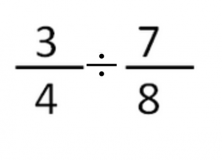

Step 1: Flip the divisor right into a reciprocalĪ reciprocal is what you multiply various through to get the price of one.

½ ÷ ⅙ = three Why is the answer larger wide variety than the fractions involved? When you divide a fragment, you’re asking what number of groups of the divisor (2ndwide variety) may be located within side the dividend (first wide variety). One of the maximum treasured matters to educate your college students while dividing fractions is what the solution manner. If you are looking for worksheets to practice dividing fractions, you can find them in our grade 5 and grade 6 math sections for dividing fractions.Teaching college students the way to divide fractions is a part of the Common Core State Standards for Mathematical Practice. Now that the denominators are the same, we can divide the numerators: This means we need to make the denominators of both fractions the same.įind a common denominators and convert each fraction to its equivalent value: Multiply the numerators and denominators:Ī longer way, and possibly more correct way, is to divide with common denominators. Invert the fraction that you are dividing by: In dividing fractions you take the reciprocal (invert the fraction) of the divisor and multiply the dividend. Here’s how that works: Dividing fractions – invert and multiply The most commonly used is what is called “invert and multiply”. There is more than one method to divide fractions.

It can be tricky to learn, but with some simple rules to follow, students can master these equations. Below we are going to tackle dividing a fraction by a fraction. In grades 5 and 6, students learn how to multiply and divide fractions.


 0 kommentar(er)
0 kommentar(er)
